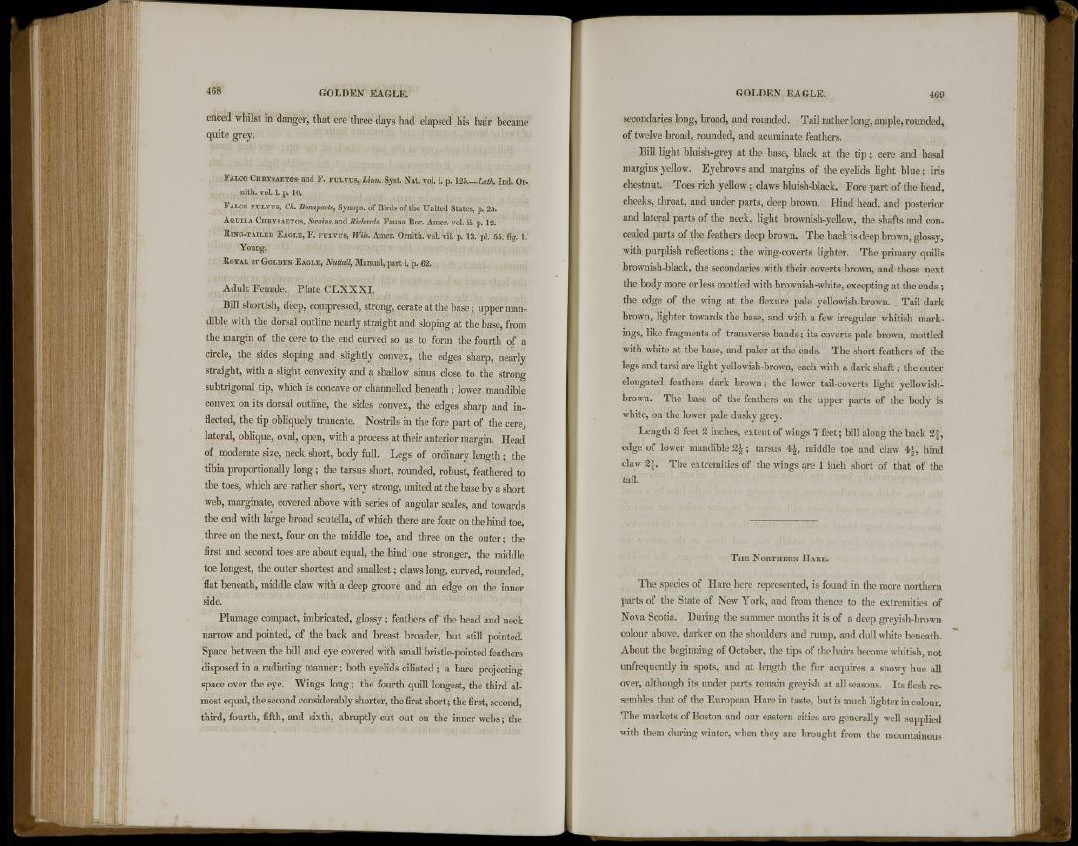
enced whilst in danger, that ere three days had elapsed his hair became
quite grey.
FALCO CHRYSAETOS- and F. FULVUS, Linn. Syst. Nat. vol. i. p. 125—Lath. Ind. Ornith.
vol. i. p. 10.
FALCO FULVUS, Ch. Bonaparte, Synops. of Birds of the United States, p. 25.
AauiLA CHRYSAETOS, Swains, and Richards. Fauna Bor. Amer. vol. ii. p. 12.
RING-TAILED EAGLE, F. FULVUS, Wits. Amer. Ornith. vol. vii. p. 13. pi. 55. fig. 1.
Young.
ROYAL or GOLDEN EAGLE, Nuttall, Manual, part i. p. 62.
Adult Female. Plate CLXXXI.
Bill shortish, deep, compressed, strong, cerate at the base; upper mandible
with the dorsal outline nearly straight and sloping at the base, from
the margin of the cere to the end curved so as to form the fourth of a
circle, the sides sloping and slightly convex, the edges sharp, nearly
straight, with a slight convexity and a shallow sinus close to the strong
subtrigonal tip, which is concave or channelled beneath ; lower mandible
convex on its dorsal outline, the sides convex, the edges sharp and inflected,
the tip obliquely truncate. Nostrils in the fore part of the cere,
lateral, oblique, oval, open, with a process at their anterior margin. Plead
of moderate size, neck short, body full. Legs of ordinary length ; the
tibia proportionally long; the tarsus short, rounded, robust, feathered to
the toes, which are rather short, very strong, united at the base by a short
web, marginate, covered above with series of angular scales, and towards
the end with large broad scutella, of which there are four on the hind toe,
three on the next, four on the middle toe, and three on the outer; the
first and second toes are about equal, the hind one stronger, the middle
toe longest, the outer shortest and smallest; claws long, curved, rounded,
flat beneath, middle claw with a deep groove and an edge on the inner
side.
Plumage compact, imbricated, glossy; feathers of the head and neck
narrow and pointed, of the back and breast broader, but still pointed.
Space between the bill and eye covered with small bristle-pointed feathers
disposed in a radiating manner; both eyelids ciliated ; a bare projecting
space over the eye. Wings long; the fourth quill longest, the third almost
equal, the second considerably shorter, the first short; the first, second,
third, fourth, fifth, and sixth, abruptly cut out on the inner webs; the
secondaries long, broad, and rounded. Tail rather long, ample, rounded,
of twelve broad, rounded, and acuminate feathers.
Bill light bluish-grey at the base, black at the tip; cere and basal
margins yellow. Eyebrows and margins of the eyelids light blue; iris
chestnut. Toes rich yellow; claws bluish-black. Fore part of the head,
cheeks, throat, and under parts, deep brown. Hind head, and posterior
and lateral parts of the neck, light brownish-yellow, the shafts and concealed
parts of the feathers deep brown. The back is deep brown, glossy,
with purplish reflections; the wing-coverts fighter. The primary quills
brownish-black, the secondaries with their coverts brown, and those next
the body more or less mottled with brownish-white, excepting at the ends ;
the edge of the wing at the flexure pale yellowish-brown. Tail dark
brown, lighter towards the base, and with a few irregular whitish markings,
like fragments of transverse bands; its coverts pale brown, mottled
with white at the base, and paler at the ends. The short feathers of the
legs and tarsi are light yellowish-brown, each with a dark shaft; the outer
elongated feathers dark brown; the lower tail-coverts light yellowishbrown.
The base of the feathers on the upper parts of the body is
white, on the lower pale dusky grey.
Length 3 feet 2 inches, extent of wings 7 feet; bill along the back 2 £ ,
edge of lower mandible 2 ^ ; tarsus 4^, middle toe and claw 4J, hind
claw 2;]. The extremities of the wings are 1 inch short of that of the
taiL
THE NORTHERN HARE.
The species of Hare here represented, is found in the more northern
parts of the State of New York, and from thence to the extremities of
Nova Scotia. During the summer months it is of a deep greyish-brown
colour above, darker on the shoulders and rump, and dull white beneath.
About the beginning of October, the tips of the hairs become whitish, not
unfrequently in spots, and at length the fur acquires a snowy hue all
over, although its under parts remain greyish at all seasons. Its flesh resembles
that of the European Hare in taste, but is much lighter in colour.
The markets of Boston and our eastern cities are generally well supplied
with them during winter, when they are brought from the mountainous